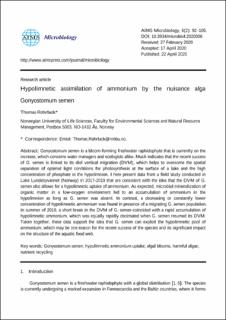Hypolimnetic assimilation of ammonium by the nuisance alga Gonyostomum semen
Peer reviewed, Journal article
Published version
Permanent lenke
https://hdl.handle.net/11250/2829660Utgivelsesdato
2020Metadata
Vis full innførselSamlinger
Sammendrag
Gonyostomum semen is a bloom-forming freshwater raphidophyte that is currently on the increase, which concerns water managers and ecologists alike. Much indicates that the recent success of G. semen is linked to its diel vertical migration (DVM), which helps to overcome the spatial separation of optimal light conditions for photosynthesis at the surface of a lake and the high concentration of phosphate in the hypolimnion. I here present data from a field study conducted in Lake Lundebyvannet (Norway) in 2017–2019 that are consistent with the idea that the DVM of G. semen also allows for a hypolimnetic uptake of ammonium. As expected, microbial mineralization of organic matter in a low-oxygen environment led to an accumulation of ammonium in the hypolimnion as long as G. semen was absent. In contrast, a decreasing or constantly lower concentration of hypolimnetic ammonium was found in presence of a migrating G. semen population. In summer of 2019, a short break in the DVM of G. semen coincided with a rapid accumulation of hypolimnetic ammonium, which was equally rapidly decimated when G. semen resumed its DVM. Taken together, these data support the idea that G. semen can exploit the hypolimnetic pool of ammonium, which may be one reason for the recent success of the species and its significant impact on the structure of the aquatic food web.
